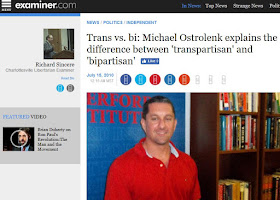July 15, 2010 12:16 AM MST
For the past several weeks, the Charlottesville-based Rutherford Institute has been hosting a summer speakers series featuring experts on a wide range of policy issues, mostly but not entirely related to the organization’s core mission of protecting basic civil liberties.
 Last Friday, July 9, Rutherford's afternoon speaker was Michael Ostrolenk, chief executive officer of the Transpartisan Center. A psychotherapist with extensive experience in political organizing and policy analysis, Ostrolenk is also affiliated with the Medical Privacy Coalition, the Liberty Coalition, and the American Conservative Defense Alliance, among other organizations.
Last Friday, July 9, Rutherford's afternoon speaker was Michael Ostrolenk, chief executive officer of the Transpartisan Center. A psychotherapist with extensive experience in political organizing and policy analysis, Ostrolenk is also affiliated with the Medical Privacy Coalition, the Liberty Coalition, and the American Conservative Defense Alliance, among other organizations.In his talk, and later in an interview with the Charlottesville Libertarian Examiner, Ostrolenk explained the meaning of “transpartisan.”
“The transpartisan imperative in American life and the necessity of it,” he said, must be seen from “four different perspectives: that we need transpartisan policies; transpartisan activities based on principles; transpartisan processes (in order to take decisions on our behalf); [and] a transpartisan analysis of the social and economic system” in which “we’re now living.”
‘Trans’ vs. ‘Bi’
He offered a distinction between “transpartisan” and the more familiar term, “bipartisan.”
“Trans,” he said, “means to transcend through and beyond the partisan.”
What differentiates that from bipartisan, he went on, is that with bipartisan, “you think of a pie and you split it half/half.”
With bipartisan, “you have the so-called left, the so-called right, the Republicans and Democrats, and then they split the difference. In that, you only have two voices; that’s why you have the ‘bi.’”
Explaining further, Ostrolenk said that “the transpartisan is a recognition that there are multiple different voices, perspectives, and worldviews operating in the world that we live in, especially here in the United States.”
That means that, “if you really want to be transpartisan, you have to listen to and integrate into your discussion all the different voices to have a bigger picture and understanding of what’s actually happening in the world, in people’s lives and community lives in the United States and the world in general.”
In contrast with bipartisan, with transpartisan, Ostrolenk continued, “you’re not splitting the difference, you’re just listening to all of the other voices and you’re trying to figure out how to integrate the different voices together, to both create a larger map of social and political reality and a way of operating inside of that map to effect positive and sustainable change in the political system.”
That sounds like a mouthful, but it really comes down to bringing people together who disagree on some issues in order to find how they might have common ground on other issues.
Practical Initiatives
Ostrolenk gave two examples of practical initiatives that the Transpartisan Center has pursued.
One, he said, “is Audit the Fed, as a project of the Campaign for Liberty. I’ve helped create a coalition, left and right, conservatives, libertarians, progressives, and liberals in support of an audit” of the Federal Reserve, with 331 cosponsors of legislation in the House of Representatives.
Another example he gave is the Campaign for a New American Policy on Iran, "which was a left-right effort that emerged about three years ago, [which] had liberals, conservatives, libertarians, and progressives coming together, recognizing that war with Iran would be majorly problematic for the United States.”
When people ask about that, “Have you guys been successful?” Ostrolenk wryly replies, “Well, we haven’t attacked Iran yet.”
The Rutherford Institute has five more speakers scheduled between now and July 26. More information can be found on the Institute’s web site.
Publisher's note: This article was originally published on Examiner.com on July 15, 2010. The Examiner.com publishing platform was discontinued July 1, 2016, and its web site went dark on or about July 10, 2016. I am republishing this piece in an effort to preserve it and all my other contributions to Examiner.com since April 6, 2010. It is reposted here without most of the internal links that were in the original.
No comments:
Post a Comment